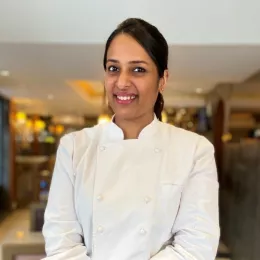The former proprietor of NYC hot spots such as Village Pourhouse, Hudson Terrace and Tres Carnes — and currently of SimpleVenue’s Sushi by Bou and Sushi Suite — stopped by ICE NYC to share his knowledge.
“And that was the third time I lost all my money.”
While this may not seem like the most inspiring anecdote for a room full of prospective restaurateurs in ICE's Restaurant & Culinary Management program, Michael Sinensky, CEO of WeShield and founder of SimpleVenue, painted a realistic picture of life in the hospitality world when he came to speak at ICE’s New York City campus.
In conversation with Rick Camac, ICE's Executive Director of Industry Relations for the Meet the Culinary Entrepreneurs series, Mr. Sinensky walked students through his (oftentimes untraditional) professional trajectory. While outlining his path from college party-thrower to owner of some of Manhattan’s most beloved bars and restaurants, including Sushi Suite and Sushi by Bou, the hospitality veteran provided some specific and hard-earned advice for the next generation.
Fixed Costs are Killer
Arguably, the origin story of Sushi by Bou and Sushi Suite, SimpleVenue’s hugely popular omakase speakeasies, was born from this reality.
After an expansion effort for his Mexican quick-serve concept tanked due to high non-negotiable rents, Mr. Sinensky committed himself to “never pay rent again.” When he happened across Chef David Bouhadana’s Sushi On Jones pop-up, he knew this was the perfect concept. What would become Sushi by Bou and Sushi Suite was a rapid-fire version of the ever popular Japanese omakase experience.
Meet More Culinary Entrepreneurs: Stephanie Izard
“You usually spend $150 or $200 and they wind up serving you a prix fixe menu in a timed experience [but] his was about ‘you have 30 minutes and $50,’” Mr. Sinensky says. “What makes this so cool is how it's so small. Eight seats is such a cool experience.”
This small footprint was a natural fit to the world of speakeasies. A far cry from its first location in a 225-square-foot hotel luggage room, Sushi Suite has now expanded to 12 locations, with continued expansion planned for 2023. Current venues include actual hotel rooms, concierge offices and even private party rooms inside other restaurants.
Marketing is Key
“You can be the best at operations, but if you have a restaurant of zero people it doesn't matter,” Mr. Sinensky says.
Crediting his marketing acumen with helping him find his way into the hospitality industry, Mr. Sinensky’s early “guerilla marketing” efforts have now moved into the digital world. Instead of sending bartenders and waiters to hand out free drink vouchers to the public before their shifts, he now sends emails.
“Anytime we want to sell something, anytime you want to sell a New Year's ticket, an experiential ticket for a tuna carving event will sell out in a minute, because we have contact data for over half a million customers,” Sinensky says. "So many one-off places [are run by] people who just want to get into the industry. If they don't have their client data, that's where they'll fail."
Meet More Culinary Entrepreneurs: Antonia Lofaso
Little Changes Make a Big Difference
Mr. Sinensky credits his early success in the hospitality field with his commitment to keeping an eye out for opportunities to improve efficiency. For example, when he noticed bartenders counting their tips to make change for the register, he added smaller bills to the register prior to opening.
Mr. Sinensky also cites something as simple as being hands-on with organizing the liquor shelves as saving time and money. For him, being hands-on “translates into taking inventory regularly to not only reduce waste, but [to give] you more depth of understanding when it comes to ordering for the business.”
Networking is Everything
When talking about how Sushi Suite came to be, Mr. Sinenksy doubled down on a theme that came up several times throughout the conversation — keeping up with contacts is key. Sushi Suite's first location and restaurant design came from a college friend showing Mr. Sinensky around a hotel he owned while trying to figure out what to do with an oddly proportioned room.
“He said ‘what can we do with this tiny 150 foot room with a 300-square-foot balcony,’” he recalls. “I told them let's put a sushi bar in…so that’s what we wound up doing. It was the first ever hotel-room-turned-restaurant in the world.”
Meet More Culinary Entrepreneurs: Tim Hollingsworth
Don’t Listen to the Noise
One of Mr. Sinensky’s more harrowing, yet enlightening, stories is the untimely demise of his hit Mexican BBQ quick-service restaurant Tres Carnes.
“We’d have lines of 100-plus people every single day at lunch time, and I let that go to my head," he says.
Eventually, the owners of Panda Express approached him about working together, with a caveat of expansion. After opening five locations within 18 months in an attempt to make the deal work, the concept folded.
"The proof of concept killed me — and it was a major, major bust," Mr. Sinensky says. "I listened to the noise of other people that made me think that I gotta open up a million places at once. And it failed miserably.”
Don’t Be a Trailblazer
While expanding too fast has its dangers, expansion over time is the key to growth, and Mr. Sinensky has some specific advice about how to do it thoughtfully.
“You have to really understand the areas that you're looking at, they have to have everything there: tourists, business and residential, all three,” he says.
This mix is the key to hitting multiple meal times: tourists for both lunch and dinner, business guests for lunch, and residential guests for dinners and weekends. (Though tourists are a notoriously fickle crowd as they don’t offer repeat business.)
The key takeaway, according to Sinensky, is the importance of the right location.
“We don’t want to be a trailblazer and open up a place, in a market where we’re going to be the first and the anchor, we want there to be other anchors," Mr. Sinensky says. "We want there to be people there already, and then use our skills and marketing to attract them to come to our business.”
Meet More Culinary Entrepreneurs: Marcus Samuelsson
Your Dreams Don’t Have to Stop When You Work for Someone Else
In responding to a direct student question, Mr. Sinensky summarized his thoughts on long term success.
“The best advice I can give an entrepreneur is to find a good job with good pay, so you can develop your own thing with the safety net of a good salary and good compensation,” he says. “Your dreams don't have to stop when you work for someone else.”
Echoing the sentiment, Rick Camac, a successful hospitality veteran in his own right, offered a quick reply: “I wish you had told me that 20 years ago.”






